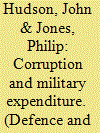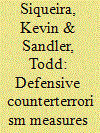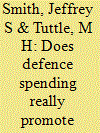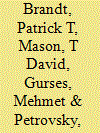|
|
|
Sort Order |
|
|
|
Items / Page
|
|
|
|
|
|
|
| Srl | Item |
| 1 |
ID:
084545


|
|
|
|
|
| Publication |
2008.
|
| Summary/Abstract |
We analyse the determinants of the number of military personnel, military expenditure and arms imports using a panel data of all available countries with data from 1984-2006. The number of military personnel increases with the extent of external threat and with conscription. There is evidence for both economies of scale and the existence of 'ghost soldiers'. Expenditure, given the number of military personnel, increases with the extent of internal threat and the area of the country. Arms imports increase with the extent of external threat, GDP per capita and corruption. Finally, both arms imports and military expenditure impact upon corruption.
|
|
|
|
|
|
|
|
|
|
|
|
|
|
|
|
| 2 |
ID:
084547


|
|
|
|
|
| Publication |
2008.
|
| Summary/Abstract |
Unlike most of the literature, this paper includes domestic political considerations in which two countries must decide defensive countermeasures against a common terrorist threat. A delegation problem arises as voters strategically choose a policymaker whose preferences differ from their own. As a consequence, countries limit the presumed oversupply of defensive countermeasures. Thus, the inclusion of domestic politics gives a new perspective on counterterrorism. The timing of elections is also shown to make a difference.
|
|
|
|
|
|
|
|
|
|
|
|
|
|
|
|
| 3 |
ID:
084552


|
|
|
|
|
| Publication |
2008.
|
| Summary/Abstract |
Many studies have examined the relationship between defense spending and growth in real aggregate output with mixed results. Most recently, Atesoglu (2002) finds a positive relationship between defense spending and output. Capturing the error correction term as the long run adjustment parameter and including the long run adjustment in the relationship, we do not find evidence that defense spending promotes growth in real output. Instead, defense spending responds to aggregate income shocks. We re-estimated the relationship and dummied all US military conflicts with similar results concerning military spending's effect on output. Interestingly, we find trade-offs between defense and non-defense government spending during war time.
* The views expressed in this paper are those of the authors and do not necessarily reflect the official policy or position of the US Air Force, the Department of Defense, or the US Government. The authors would like to express their thanks for the comments from Craig Stone and the other participants at the 2006 Canadian Economics Association conference, as well the comments received from three anonymous referees and the editor.
|
|
|
|
|
|
|
|
|
|
|
|
|
|
|
|
| 4 |
ID:
084554


|
|
|
|
|
| Publication |
2008.
|
| Summary/Abstract |
This paper sets up a monetary endogenous growth model, and uses it to explain the ambiguous linkage between the military burden and the inflation rate observed in existing empirical studies. It is found that an expansion in the military burden has an ambiguous effect on the inflation rate depending upon the relative extent of two conflicting forces. More specifically, if the increase in the marginal benefit from holding money exceeds (falls short of) the increase in the marginal product of private capital, the inflation rate will rise (fall) in response. Moreover, it is found that an increase in the military burden will stimulate the balanced growth rate, confirming Benoit's famous empirical findings.
|
|
|
|
|
|
|
|
|
|
|
|
|
|
|
|
| 5 |
ID:
084555


|
|
|
|
|
| Publication |
2008.
|
| Summary/Abstract |
Developments within the UK in the Ministry of Defence's policy on defence equipment acquisition demand changes in the scale and allocation of the Ministry's budget for defence research. To facilitate the national debate on those changes, this paper reviews the key questions about UK defence research which the Ministry must resolve in order to implement its new Defence Technology Strategy.
|
|
|
|
|
|
|
|
|
|
|
|
|
|
|
|
| 6 |
ID:
084553


|
|
|
|
|
| Publication |
2008.
|
| Summary/Abstract |
By testing for structural breaks in defense expenditures, the dates of change in the pattern of defense expenditures for the NATO allies are determined. If NATO members are responding to a common threat, the breaks should be similar, in both direction and dates, for defense expenditures. The breaks should occur during major NATO strategy shifts. The results of the structural analysis tests suggest that NATO allies do not have an integrated response to NATO-specific defense issues. It appears that NATO members, in general, adjusted their defense spending according to economic imperatives, political issues, and ally-specific defense agendas.
|
|
|
|
|
|
|
|
|
|
|
|
|
|
|
|
| 7 |
ID:
084551


|
|
|
|
|
| Publication |
2008.
|
| Summary/Abstract |
Previous research has shown that the duration of a civil war is in part a function of how it ends: in government victory, rebel victory, or negotiated settlement. We present a model of how protagonists in a civil war choose to stop fighting. Hypotheses derived from this theory relate the duration of a civil war to its outcome as well as characteristics of the civil war and the civil war nation. Findings from a competing risk model reveal that the effects of predictors on duration vary according to whether the conflict ended in government victory, rebel victory, or negotiated settlement.
|
|
|
|
|
|
|
|
|
|
|
|
|
|
|
|
|
|
|
|
|